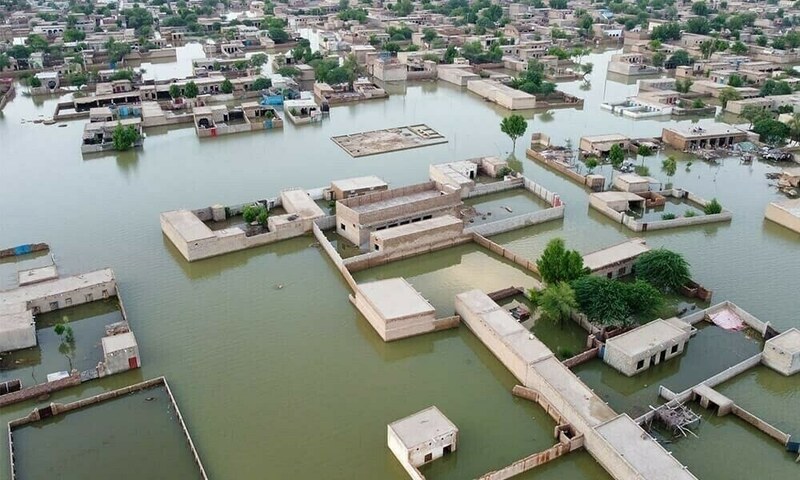By Mirza M Hamza
Copyright brecorder

Pakistan has survived three states since 1947: the partition state, the truncated state after 1971, and the praetorian state since 1977. The 2025 floods are birthing a fourth: the hunger state. For the first time since independence, the question has shifted from who governs Pakistan to whether Pakistan can govern at all.
The floods ravaging Pakistan mark the third act in a civilizational breakdown. The 2010 deluge killed 2,000 people and destroyed USD 9.7 billion worth of infrastructure, yet no lessons were learnt.
Since no heed was paid to early warning systems, improved flood defenses, or institutional memory, the floods returned just as strong after 12 years. In 2022, one-third of our country was again submerged, affecting 33 million people, plunging the rupee down which lost 22 percent of its value against the dollar within months.
Our response is shock rather than preparedness. Now in 2025, with Punjab’s three major rivers recording simultaneous peaks, even government ministers admit this is “the biggest flood in Punjab’s history.”
This particular catastrophe is different due to two reasons. India, which was somewhat better off during the floods of 2010 and 2022, now faces its worst floods in four decades, with 148,000 to 175,000 hectares of Punjab farmland underwater. This means both countries would be competing for the same shrinking global grain supply, not immediately, but inevitably when the next climate shock arrives.
Secondly, the monsoon floods come in the aftermath of heightened tensions, which has left a far more hostile India manipulating river flows upstream, holding the Indus Waters Treaty in abeyance. Thus, for the first time, we are seeing all “Indian” rivers flowing westward.
Two million people have been evacuated in Pakistani Punjab alone, with 4,000 villages submerged. These displaced millions now depend on a distribution system that cannot deliver food from warehouses to relief camps. As per USDA figures, Pakistan had 5 million tons of wheat in storage as of April, though flood waters damaged portions. Still, flood victims face hunger. This is more an issue of immobility than availability. Amid this crisis, wheat prices have spiked 20 percent despite the theoretical surplus, revealing that abundance means nothing without functioning logistics.
Pakistan produced a record 31.4 million tons of wheat in 2024/25 against annual consumption of 31.9 million tons. The wheat harvest was largely complete before the 2025 floods struck. While the floods destroyed 60 percent of Punjab’s rice crop and 30 percent of sugarcane, the next wheat crop faces a different threat: a 42 percent rainfall deficit and 7 percent reduction in planted area will likely reduce production to 27.5 million tons in 2025/26.
Having an excess of 5 million tons, we need to import only 1.7 million tons, which can be managed at a cost of about USD 500 million. Hence this year, fortunately for Pakistan, we can survive on our surplus.
It is essential to mention that our farmers are already distressed and displeased. Earlier in 2023-24, farmers in Pakistan suffered great losses amounting to a total of Rs 380 billion, when the previous government mysteriously imported 3.5 million tons of wheat, crashing domestic prices. They now receive Rs 2,700–3,200 per 40kg against production costs of Rs 3,200–3,400, losing hundreds of rupees on every unit produced.
Coupled with IMF pressure, this has wreaked complete havoc. The price floor that guaranteed the purchase of 5.6 million tons annually has been removed. Farmers have been forced to absorb losses from the import scandal, below-cost prices, and recent flood devastation—with no safety net. This has discouraged farmers from cultivating wheat altogether. The 7 percent reduction in planted area this season is a premonition of an impending agricultural collapse.
Our 5 million-ton buffer, already partially damaged in flooded warehouses, will shrink to barely 2 million tons by mid-2026. When the next flood arrives, we face a different equation entirely. A repeat of 2025’s devastation would leave us with perhaps 20 million tons of production against 32.5 million tons of consumption.
The import requirement jumps to 10–12 million tons, costing USD 3–3.5 billion at current prices that we don’t have. At that point, Pakistan would be bidding for grain just as India restocks; even modest Indian tenders would tighten an already thin market. Today we compete with anyone for grain; tomorrow we compete with everyone.
Time is no one’s friend. We failed miserably in mitigating this crisis; we cannot afford to miss another deadline. While we can muddle through 2025/26 using our stocks, the decisions made now would ultimately determine the fate of Pakistan.
Our choices today would determine whether we face manageable hardship or mass hunger tomorrow. November 2025 remains the last viable window to lock in regional grain agreements. By January 2026, foreign exchange pressure will mount as even modest imports require letters of credit.
March 2026 will reveal whether farmers, hard-pressed by the liberalization drive and have been affected by floods losses, have been able to cultivate new grain or not. The true breaking point, however, would come in October 2026. This point will determine if we have enough institutional resilience to meet another crisis, especially after depleted food supplies.
Today, despite the damage, Pakistan can still juggle its contradictions. It can use its stocks to avoid massive food imports while also maintaining IMF compliance. Hence, this year we can prevent immediate hunger. But what if the floods hit again next year? The numbers clarify that Pakistan cannot simultaneously maintain currency stability, ensure food security, and service external debt.
Here we are presented with the “impossible trinity”, which offers no escape. If we choose any two, the third will collapse with mathematical certainty.
Suspending debt payments to finance 10–12 million tons of grain would almost certainly trigger sovereign default. Expanding money for imports while servicing debt would push flour prices beyond urban affordability. Prioritizing reserves and debt obligations while limiting would lead directly to famine.
The IMF demanded elimination of agricultural subsidies as a condition for our USD 7 billion programme. These were implemented just as climate disasters intensified. With every month of compliance with market liberalization, we succeed only in destroying our capacity to mitigate the next shock.
The dismantling of provincial food departments, withdrawal from wheat procurement, and abandonment of price supports, all IMF requirements, are ingredients for the perfect storm even before the storm. If IMF withdraws its support, Pakistan would lose its credit worthiness. If Pakistan complies fully to meet IMF dictated policies and debt repayment, millions starve. There is no viable path within the existing framework.
The window for action is rapidly narrowing. Before December 2025, Pakistan must map intact versus damaged wheat stocks and establish transparent distribution protocols to flood camps. Import agreements for 1.7 million tons must be locked at current prices of USD 290 per ton through government-to-government deals with China or Russia, using deferred payment mechanisms.
Farmers need immediate emergency credit lines and 18-month loan deferrals, or next season’s planting will collapse entirely. By January 2026, we must renegotiate IMF terms to include climate emergency provisions, allowing temporary support price restoration. Without these steps, foreign exchange pressure will surge.
Wheat imports of about USD 500 million, billions in reconstruction costs, and lost rice export revenues will consume roughly half of our USD 19.66 billion reserves before the next monsoon arrives. These are nonetheless stop-gap arrangements.
To really succeed in mitigating crises, both economic and natural, Pakistan needs revolutionary restructuring rather than marginal reforms. The feudal agricultural system that leaves farmers selling below cost needs to change. This system cannot survive in this age of climate volatility. We also need to address our distribution infrastructure. With the current set up, the immobility of grain from warehouses to flood victims during another crisis will fail catastrophically when stocks are depleted.
The political system that allowed import scandals while farmers suffered, that beats protesting farmers with batons while their livelihoods drown, cannot manage what’s coming. The three big floods have already washed away whatever resilience we did have. There is no recourse left.
The threat of famine has likely receded for now. Our warehouses still hold grain, even if some portions are flood-damaged and we cannot distribute it properly. But are we methodically eliminating every mechanism that could prevent hunger tomorrow? The 2025 floods did not create the hunger state; they did however reveal how close Pakistan is from it. When that next flood arrives, we will discover we traded our resilience for one year of false stability.
The mathematics presents an unforgiving picture of the future. Today’s surpluses become tomorrow’s subsistence, then starvation. The hunger state can be a monsoon away, and we are doing nothing to prevent it.
Copyright Business Recorder, 2025



